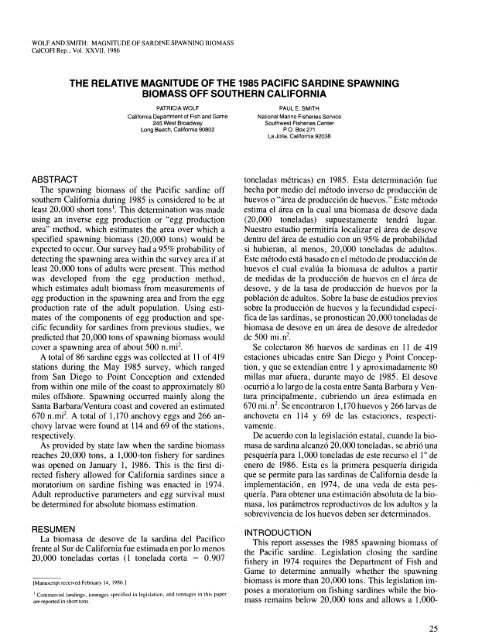CalCOFI Reports, Vol. 27, 1986 - California Cooperative Oceanic ...
CalCOFI Reports, Vol. 27, 1986 - California Cooperative Oceanic ...
CalCOFI Reports, Vol. 27, 1986 - California Cooperative Oceanic ...
- No tags were found...
You also want an ePaper? Increase the reach of your titles
YUMPU automatically turns print PDFs into web optimized ePapers that Google loves.
WOLF AND SMITH: MAGNITUDE OF SARDINE SPAWNING BIOMASS<strong>CalCOFI</strong> Rep., <strong>Vol</strong>. XXVII, <strong>1986</strong>THE RELATIVE MAGNITUDE OF THE 1985 PACIFIC SARDINE SPAWNINGBIOMASS OFF SOUTHERN CALIFORNIAPATRICIA WOLF<strong>California</strong> Department of Fish and Game245 West BroadwayLong Beach, <strong>California</strong> 90802PAUL E. SMITHNational Marine Fisheries ServiceSouthwest Fisheries CenterP.O. Box <strong>27</strong>1La Jolla, <strong>California</strong> 92038ABSTRACTThe spawning biomass of the Pacific sardine offsouthern <strong>California</strong> during 1985 is considered to be atleast 20,000 short tons’. This determination was madeusing an inverse egg production or “egg productionarea” method, which estimates the area over which aspecified spawning biomass (20,000 tons) would beexpected to occur. Our survey had a 95% probability ofdetecting the spawning area within the survey area if atleast 20,000 tons of adults were present. This methodwas developed from the egg production method,which estimates adult biomass from measurements ofegg production in the spawning area and from the eggproduction rate of the adult population. Using estimatesof the components of egg production and specificfecundity for sardines from previous studies, wepredicted that 20,000 tons of spawning biomass wouldcover a spawning area of about 500 n.mi2.A total of 86 sardine eggs was collected at 11 of 419stations during the May 1985 survey, which rangedfrom San Diego to Point Conception and extendedfrom within one mile of the coast to approximately 80miles offshore. Spawning occurred mainly along theSanta BarbardVentura coast and covered an estimated670 n.mi2. A total of 1,170 anchovy eggs and 266 anchovylarvae were found at 114 and 69 of the stations,respectively.As provided by state law when the sardine biomassreaches 20,000 tons, a 1,000-ton fishery for sardineswas opened on January 1, <strong>1986</strong>. This is the first directedfishery allowed for <strong>California</strong> sardines since amoratorium on sardine fishing was enacted in 1974.Adult reproductive parameters and egg survival mustbe determined for absolute biomass estimation.RESUMENLa biomasa de desove de la sardina del Pacific0frente a1 Sur de <strong>California</strong> fue estimada en por lo menos20,000 toneladas cortas (1 tonelada corta = 0.907[Manuscript received February 14, <strong>1986</strong>.1’ Commercial landings, tonnages specified in legislation. and tonnages in this paperare reported in short tons.toneladas metricas) en 1985. Esta determinacion fuehecha por medio del mCtodo inverso de produccion dehuevos o “area de produccion de huevos.” Este metodoestima el area en la cual una biomasa de desove dada(20,000 toneladas) supuestamente tendra lugar.Nuestro estudio permitiria localizar el area de desovedentro del &-ea de estudio con un 95% de probabilidadsi hubieran, al menos, 20,000 toneladas de adultos.Este mCtodo esta basado en el metodo de produccion dehuevos el cual evalua la biomasa de adultos a partirde medidas de la produccion de huevos en el area dedesove, y de la tasa de produccion de huevos por lapoblacion de adultos. Sobre la base de estudios previossobre la produccion de huevos y la fecundidad especificade las sardinas, se pronostican 20,000 toneladas debiomasa de desove en un &-ea de desove de alrededorde 500 mi.n2.Se colectaron 86 huevos de sardinas en 11 de 419estaciones ubicadas entre San Diego y Point Conception,y que se extendian entre 1 y aproximadamente 80millas mar afuera, durante mayo de 1985. El desoveocurrio a lo largo de la costa entre Santa Barbara y Venturaprincipalmente, cubriendo un area estimada en670 mi.n2. Se encontraron 1,170 huevos y 266 larvas deanchoveta en 114 y 69 de las estaciones, respectivamente.De acuerdo con la legislacion estatal, cuando la biomasade sardina alcanz6 20,000 toneladas, se abri6 unapesqueria para 1,000 toneladas de este recurso el 1 O deenero de <strong>1986</strong>. Esta es la primera pesqueria dirigidaque se permite para las sardinas de <strong>California</strong> desde laimplementation, en 1974, de una Veda de esta pesqueria.Para obtener una estimacidn absoluta de la biomass,10s parametros reproductivos de 10s adultos y lasobrevivencia de 10s huevos deben ser determinados.INTRODUCTIONThis report assesses the 1985 spawning biomass ofthe Pacific sardine. Legislation closing the sardinefishery in 1974 requires the Department of Fish andGame to determine annually whether the spawningbiomass is more than 20,000 tons. This legislation imposesa moratorium on fishing sardines while the biomassremains below 20,000 tons and allows a 1,000-25















